
How do you tell a story that has no beginning, middle, or end?
Most of the time, narrative design is the art of arranging spaces so that traversing them traverses the story. But we constantly make games without corridors or locks in them. We make games where players can go off into very disparate directions, or where randomness determines a lot of what happens. Video games have no fixed structure, and as a result neither do video game narratives. This is the exciting aspect of narrative design: Game designs are constantly throwing out new problems that have to be solved by coming up with new narrative structures and conventions.
In building game narratives, we usually hang story information off the mechanical elements of the game. Objects in an RPG have descriptions that players can view alongside their stats; entering rooms in an exploration-driven game can trigger cutscenes; NPC characters react to the world around them with dialogue. But many games have mechanical elements that players encounter in a random or semi-random order, precluding conventional narrative.
I’m grappling with this problem right now in my own work. Part of that process is looking at antecedents, at other designers who dealt with this before, and trying to look for commonalities; trying to look for things that work well.
Fifteen Random Cards
Magic: The Gathering, the original trading card game, is well over 20 years old now. Magic, in its paper incarnation, is sold in packs of 15 random cards; the designers can’t dictate the order in which players first see the product, they can only dictate the frequency with which certain elements show up in the cards.
This limitation would seem to make inserting narrative directly into the game impossible. Blizzard’s Magic replacement therapy, Hearthstone, doesn’t bother with narrative at all: its cards are smaller, fitting both less art and less text, and “flavor text” doesn’t display by default in the game. For a long time, Magic’s designers agreed, leaving the game’s convoluted, multiverse-spanning metaplot out of the cards themselves.
As of the last year or so however, Magic has explicitly pushed storytelling to the forefront of the game’s identity. It’s easy to see why: Narrative and worldbuilding set it apart from Hearthstone and other competitors. Magic’s multiverse-hopping conceit lets it come to an all new world (or return to a fan favorite that wasn’t seen for years) with every new expansion. The panoply of fantasy illustrators it uses gives it a distinct sense of authorship and texture.
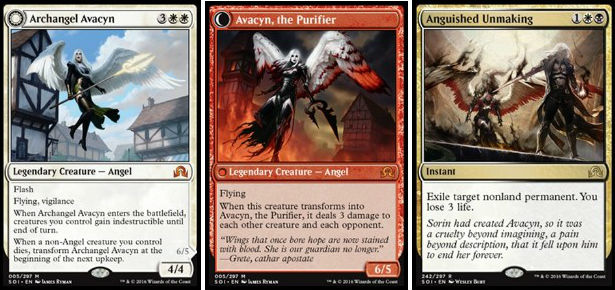
Magic’s story is experienced by most players at a sort of distance, in the same way that people who “follow” wrestling but don’t actually sit down to watch most of it might know about feuds and titles but not necessarily every detail. It’s absorbed more through osmosis than as a discrete experience; appropriate to the fact that Magic releases new cards four times a year, and players will see those cards a lot in the intervening time. In the game itself, the little triptych above will basically never be seen in order by someone opening packs. Both cards involved are rare, so they won’t normally show up together in a pack; and Anguished Unmaking shows up about twice as often as Avacyn.
But the realisation is that it doesn’t necessarily matter; all of the cards work as self-contained moments of meaning, and if you meet the resolution before the set-up, then they will just switch places cleanly--the resolution becomes a mystery that the set-up is the solution to. Magic is often characterised as a game about discovery, and so the archaeological process of piecing its narrative together from randomly-ordered pieces feels natural to it.
Drops of Honey
Fallen London is arranged as a bundle of discrete “storylets” that players unlock gradually with in-game resources and traits. At any given time, a player has a dozen of those that they could look into; and in addition to that, there are also randomly available opportunities, pulled from a deck of cards.
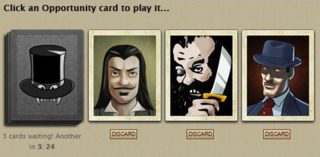
Sometimes, the connections between those discrete story chunks is used to present traditionally connected stories that are more like sub-games contained as stories within Fallen London. But they all interplay with one another; player choice, and random chance, plays a large role in how players encounter the story.
Authorial control is exercised mostly by gating. From the huge number of stories that the game features, you only see a small portion, culled by referencing your characteristics. Characteristics in Fallen London (And its nautical sibling, Sunless Sea) are similar to RPG statistics in other games. Except they are numerous and extremely granular; they run from overarching descriptions of the player character’s traits to numbers that track progress in individual quests, to resources held by the player. The opportunity card deck is similar; you only see stories that you’re eligible for, and not all stories are equally likely to show up.
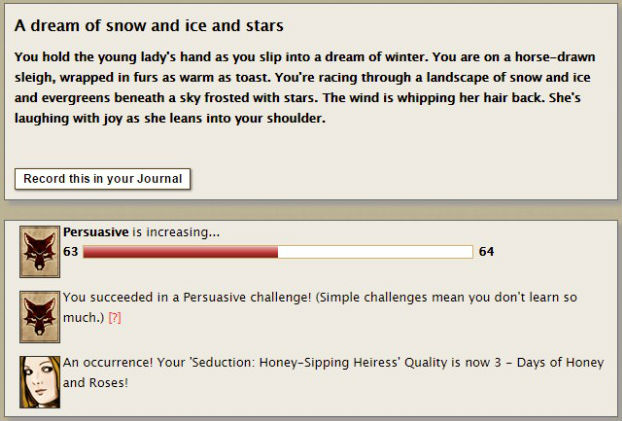
Many things you can do in Fallen London are gated with one of the game’s many currencies and resources, whether it be echoes (the money used in the game’s subterranean London), information, or something altogether more exotic. Those resources are often highly interchangeable; “secrets” are treated as a fungible commodity. What this means is that a player can encounter a story they want to play and then go play an entirely unrelated series of stories to get the required resources. You can go do a bunch of jobs for Hell, then donate the money to the Church to curry favor with the clergy. The dramatic irony here belongs completely to the player, and the game’s resource-exchanging mechanics lend themselves to those sorts of miniature, player-driven character arcs.
Fallen London’s minimalist, evocative prose style is the glue that holds this process together. Giving a minimal amount of detail lets players fill in the gaps as they make connections between one thing and another. Ambiguity, here, is a virtue. No two players experience the same Fallen London, and previous events can often be reinterpreted to fit what the player experiences later. Every detail you give the player is another thing they can find an inconsistency in; so giving them only the evocative and essential is ideal.
Tragedy Is Just Death with Context
Apophenia is the psychological phenomenon where people assign meaning or intentionality to random data; the most common example is pareidolia, seeing faces in random objects (such as the front of a car or a piece of toast). Few games lean more heavily on apophenia for their narrative than Paradox’s grand strategy titles, particularly Crusader Kings II. With thousands of counts, dukes, kings and emperors as playable characters, the game has to produce tales of courtly intrigue out thin air.
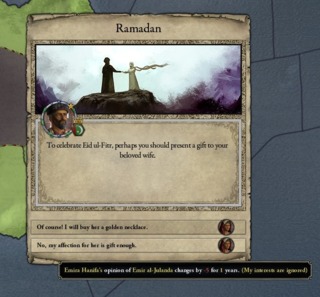
The game’s characters--thousands of them being simulated at any given time--are all fairly thin in mechanical terms; they have stats and a handful of traits. Storytelling comes from events, which happen largely at random and assign roles to those characters in ongoing intrigues. Players, in turn, will put those discrete happenings into the form of a narrative. A few mechanically unrelated events involving the same courtier will, in the player’s mind, form a pattern of behavior that gives them personality beyond those stats. Players eventually have stories of their secret nemesis, their sycophant, their frenemy, and so on. Or, in one memorable game at a time when the game’s romance mechanics were a bit out of whack, the sultan who had to divorce seven wives because they all cheated on him with the same emir.
This works because of the game’s tight mechanical focus. Almost every system in Crusader Kings II is ruled by its vast cast of characters. Characters command armies, act as advisors to monarchs, inherit lands, plot and perform assassinations. Everything every character does is fitted into a complicated context of social relationships, from which players will naturally pluck those bits of data that provide meaning. While the system is tuned to incorporate this meaning--jealousy, rivalry, ambition, cowardice, love, and treachery are all character stats of some kind or another in this game--CKII really sings when players can assign character arcs to the events triggered by those mechanical traits. The context of previous events is what turns a noble acting against their liege into betrayal, or a death in battle into tragedy.
From the Outside, Inwards
Receiver is probably best known for its ultra-detailed take on first-person shooter mechanics: Operating the relatively simple handguns you handle in that game requires the use of about a third of your keyboard, as you pull back slides, push magazine releases, turn the safety on and off, and so on.
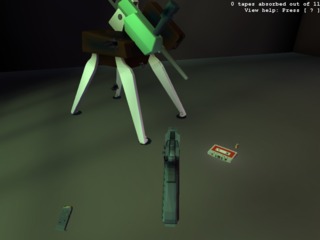
It does also have a narrative, however, a gnostic conspiracy scenario that you encounter only in the form of audio tapes scattered randomly in the game’s procedurally-generated levels. Those tapes are a true aleatory narrative; you can encounter them in any order, and though each one is largely self-contained, they are all just pieces of a puzzle. The beauty of this design is that Receiver is an unfairly difficult game with permadeath; and while gathering all 20 tapes in a single playthrough is the ultimate goal, it is still very rewarding to gradually understand the story by gathering a tape here and there in several individual attempts. The randomness, rather than obscuring, reveals.
Where Do Games Exist?
Making the narrative aspect of these games work requires a specific kind of storytelling: Stories composed out of discrete, self-contained chunks that don’t fall apart when presented out of context or rearranged. Stories that cling tightly to the mechanical bones of the game, keeping the player from having to rely on narrative information they may not have gotten yet. Games that have a discovery aspect to them, where players are willing to overlook the things they don’t understand right now because of the later satisfaction of figuring them out.
What ties all of these together is that they’re a confluence of mechanical and creative choices that allow a narrative to be felt by the player, even though the game’s designers didn’t structure their chunks of story into a specific narrative. Which is to say, this technique of card deck storytelling brings us back to one of the fundamental ideas of game design, one that we have a tendency to forget too often: Games don’t exist in the machine, nor in the player, but somewhere in between the two. Both game and player are contributing something, and nothing works without both of those contributions. This is why witnessing a game as opposed to playing it only really becomes a reality for most once we have streaming and recording on platforms like Twitch and YouTube. A game can’t be viewed as an object, it has to be watched as a performance. It requires a performer, a player.
The upshot of all this is that you can build narrative by crafting perfectly-assembled and self-sufficient parts, even though the structure they fit into is procedural and chaotic. A structure that repels conventional narrative can still be fitted to a story, given a particular way of constructing that story.
For me, this presents two questions that I don’t have good answers for at the moment: What other game forms are we neglecting to insert narrative into because we think it wouldn’t work? And, is the “conventional” in games narrative actually well-fitted to the games that use it?
Bruno Dias is a game developer and writer based in São Paulo, Brazil. He writes interactive fiction and develops tools for doing so. His work can be found on Sub-Q Magazine and on his blog. He himself can often be found on Twitter.
Log in to comment